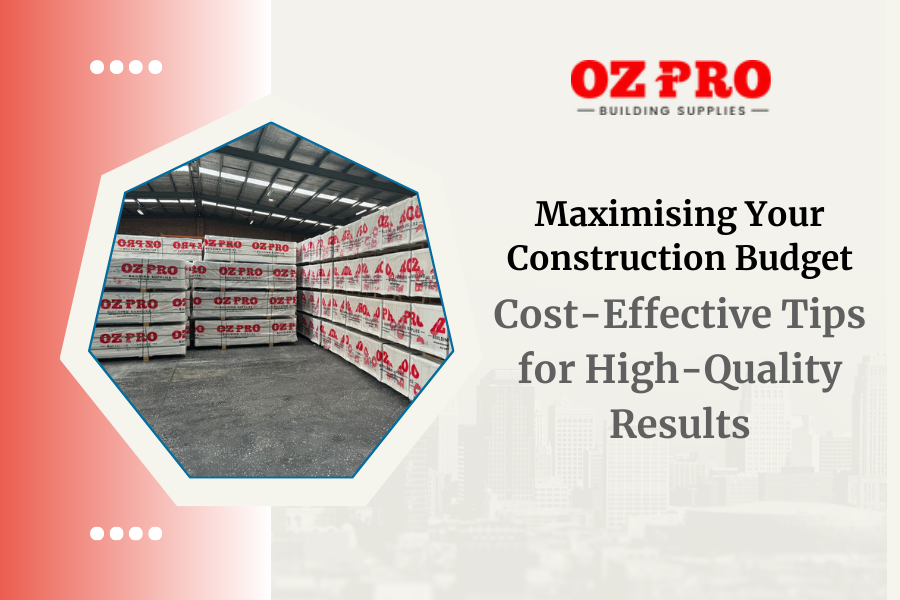Embarking on a construction project—whether it’s a new build, renovation, or upgrade—requires careful budget management. High-quality results don’t always necessitate a hefty price tag. With strategic planning and smart choices, you can achieve excellent outcomes while keeping costs under control. Here’s how to make the most of your construction budget without compromising on quality of building materials.
1. Prioritise Planning and Design
The foundation of a successful construction project is a well-thought-out plan. Before any construction begins, invest time in developing a detailed plan and design. This includes crafting a comprehensive blueprint that covers every aspect of the project. Detailed plans can help avoid costly changes and unforeseen issues later on. Collaborate with a reputable architect or designer to ensure your design meets your needs and remains within budget. Proper planning minimises the risk of expensive modifications and ensures a smoother construction process.

2. Choose the Right Building Materials
Selecting appropriate building materials is crucial for managing costs and ensuring project longevity. While high-quality materials might come with a higher initial price, their durability can lead to savings over time. For example, investing in waterproof hybrid flooring can protect against moisture and wear, reducing the need for frequent replacements. Similarly, high-performance construction grout can enhance the durability of finishes, leading to fewer repairs in the future. Opt for materials that offer a balance of quality and cost-effectiveness, ensuring that they contribute to the project’s long-term success.
3. Opt for Cost-Effective Flooring Solutions
Flooring often represents a significant portion of your construction budget. To maximise value, consider cost-effective options such as waterproof hybrid flooring. This type of flooring combines durability and water resistance with affordability, making it suitable for various applications. Additionally, waterproof hybrid flooring is easy to maintain, which can result in savings on cleaning and repair costs over time. By choosing a flooring solution that offers both functionality and cost efficiency, you can enhance the overall value of your project.
4. Invest in Quality Tile Adhesive
Tile adhesive is a critical component of any tiling project. Selecting high-quality adhesive ensures a strong bond between tiles and the substrate, preventing issues like tiles popping off or shifting. Look for adhesives that offer superior adhesion, flexibility, and additional benefits such as water resistance. Although high-quality tile adhesive may come with a higher upfront cost, it can prevent costly repairs and replacements in the future. Investing in quality adhesive ensures that your tiling project remains intact and visually appealing for years to come.
5. Utilise Self-Levelling Concrete Floors
For projects involving concrete floors, self-levelling concrete is a practical and cost-effective choice. This type of concrete is designed to create a smooth, even surface without requiring extensive labour. It is particularly useful for correcting uneven floors and providing a solid foundation for additional finishes. Using self-levelling concrete can reduce labour costs and enhance the overall quality of your flooring. Additionally, it simplifies the installation process, leading to a more efficient and cost-effective project.
6. Plan for Efficient Use of Construction Materials
Efficiency in material use can lead to significant savings. Carefully calculate the quantities of materials needed to avoid over-purchasing or waste. Work closely with your contractor to ensure that materials are utilised effectively and that any leftovers are used appropriately. Efficient material use not only helps control costs but also minimises environmental impact. By avoiding waste and optimising material use, you contribute to both financial and environmental sustainability.

7. Explore Bulk Purchasing and Discounts
Purchasing materials in bulk can often result in cost savings. Many suppliers offer discounts for larger orders, so if you have the storage space and the materials are durable, buying in bulk can be a smart financial decision. Additionally, keep an eye out for sales and special promotions from suppliers, which can provide further savings. Bulk purchasing and discount opportunities can help stretch your budget further while ensuring you have the materials needed for your project.
8. Consider Alternative Materials
Alternative materials can sometimes offer similar benefits at a lower cost. For example, while traditional ceramic tiles are popular, alternatives like vinyl or laminate can provide similar aesthetics and performance for a fraction of the cost. When exploring alternatives, ensure they meet the necessary quality and durability standards for your project. By considering cost-effective alternatives, you can achieve the desired look and functionality while staying within budget.
9. Invest in Professional Installation
Although DIY installation might seem like a way to save money, professional installation often results in better outcomes and long-term savings. Experienced contractors are skilled in avoiding common mistakes and delivering high-quality workmanship. Investing in professional installation can prevent costly repairs and replacements in the future, ultimately saving you money. Professional installers ensure that every aspect of the project is completed to a high standard, reducing the risk of issues down the line.
10. Monitor and Manage Your Budget
Regularly monitoring your construction budget is essential for staying on track. Keep detailed records of all expenses and compare them to your initial budget. Address any discrepancies promptly to avoid budget overruns. Effective budget management also involves making informed decisions about potential changes or upgrades based on their impact on overall costs. By staying vigilant and proactive, you can ensure that your project remains within budget while achieving the desired results.
Conclusion
Maximising your construction budget doesn’t mean sacrificing quality. By prioritising careful planning, choosing the right materials, and making smart decisions about flooring, tile adhesive, and concrete, you can achieve excellent results while staying within financial limits. With these cost-effective tips, you can ensure that your construction project not only meets but exceeds your expectations, delivering high-quality results that stand the test of time.

